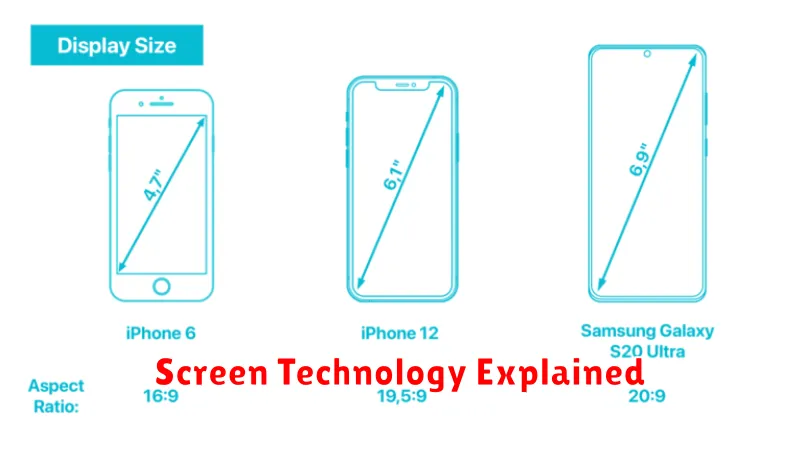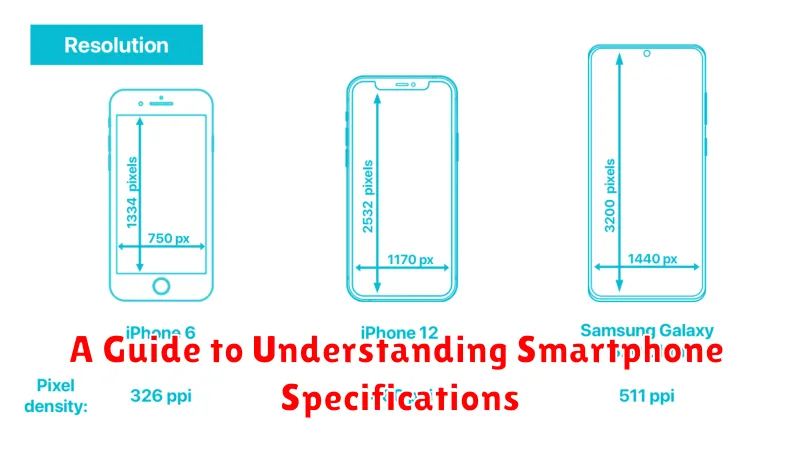Purchasing a new smartphone can be an overwhelming experience. With so many brands and models available, navigating the sea of specifications can feel daunting. Understanding key smartphone specifications is crucial for making an informed decision and choosing the device that best suits your needs and budget. This guide will demystify the technical jargon, providing a clear explanation of the most important smartphone specifications, from processor and RAM to camera and battery life. Learn what to look for and how to interpret these specs to find the perfect smartphone.
This comprehensive guide breaks down the essential smartphone specifications into digestible sections. By the end, you will be equipped with the knowledge to confidently compare smartphones and choose the one that aligns with your priorities, whether it’s a powerful processor for gaming, a long-lasting battery, or a stunning camera. Explore the key specs, learn their significance, and empower yourself to make a smart smartphone purchase.
Processor Types and Performance
The processor, often called the CPU (Central Processing Unit) or SoC (System on a Chip), is the brain of your smartphone. It dictates how quickly your phone performs tasks, from opening apps to rendering graphics. Understanding processor types and their performance is crucial for selecting a smartphone that meets your needs.
Processors vary by manufacturer (e.g., Qualcomm Snapdragon, MediaTek, Apple Bionic) and model number. Higher model numbers generally indicate newer and more powerful processors within the same brand.
Core count and clock speed are key performance indicators. More cores allow for better multitasking, while higher clock speeds mean faster individual task completion. However, these are not the only factors. Architecture and manufacturing process also play a significant role in overall performance.
Understanding RAM and Storage
Random Access Memory (RAM) and storage are two crucial components that significantly impact a smartphone’s performance. While they both store data, they serve distinct purposes and have different characteristics.
RAM is volatile memory that temporarily stores data actively used by the device. A larger RAM capacity allows your smartphone to run more apps simultaneously and switch between them smoothly without reloading. Think of it as your phone’s short-term memory.
Storage, on the other hand, is non-volatile memory that permanently stores data such as apps, photos, and videos. Storage capacity determines how much data your phone can hold. This is akin to your phone’s long-term memory. Common storage types include eMMC and the faster UFS.
Screen Technology Explained

Smartphone displays utilize various technologies, each offering different advantages. Understanding these technologies is crucial for making informed purchasing decisions. Two prominent types are LCD (Liquid Crystal Display) and OLED (Organic Light Emitting Diode).
LCD screens rely on a backlight to illuminate the pixels. Different LCD subtypes, like IPS LCD, offer wider viewing angles and better color reproduction. LCDs are generally more power-efficient than older OLED technologies, but can suffer from less vibrant colors and lower contrast ratios.
OLED screens, on the other hand, have self-emitting pixels, eliminating the need for a backlight. This allows for true blacks and infinite contrast ratios, resulting in a more vibrant and dynamic image. OLED screens are also generally thinner and more flexible, enabling curved displays.
Camera Specifications Demystified
Understanding camera specifications is crucial for choosing the right smartphone. This section breaks down the key specs and their impact on image quality.
Megapixels (MP)
Megapixels represent the resolution of the image sensor. A higher megapixel count allows for larger prints and more detail, but it isn’t the sole determinant of image quality.
Aperture (f-number)
Aperture, denoted by an f-number (e.g., f/1.8), controls the amount of light entering the lens. A lower f-number signifies a wider aperture, allowing for better low-light performance and depth-of-field effects.
Sensor Size
A larger sensor generally captures more light and detail, resulting in improved image quality, especially in challenging lighting conditions.
Battery Capacity and Charging
Battery capacity, measured in milliampere-hours (mAh), indicates the amount of charge a battery can hold. A higher mAh generally translates to longer usage time. However, actual battery life depends on various factors including screen brightness, app usage, and network connectivity.
Charging speed is determined by the charging technology supported by the phone and the charger used. Fast charging technologies, often proprietary, deliver higher power to the battery, reducing charging time significantly. Look for specifications like “fast charging,” “rapid charging,” or specific wattage (e.g., 18W, 30W) to understand charging capabilities.
Connectivity Options
Connectivity is a crucial aspect of any smartphone. It dictates how your device interacts with the world. Understanding these options helps you choose a phone that fits your needs.
Cellular Connectivity: This refers to the phone’s ability to connect to cellular networks for voice calls, text messages, and mobile data. Key considerations include network compatibility (e.g., 4G LTE, 5G) and data speeds.
Wi-Fi: Most smartphones support various Wi-Fi standards (e.g., 802.11ac, Wi-Fi 6). Look for the latest standards for faster speeds and better performance.
Bluetooth: This allows for short-range wireless connections to accessories like headphones, speakers, and smartwatches. Bluetooth version (e.g., 5.0, 5.2) impacts speed and range.
NFC (Near Field Communication): NFC enables contactless payments and data transfer between devices. It’s essential for services like mobile wallets.
Operating System Versions
The operating system (OS) is the software that manages all of the hardware and software on a smartphone. It is the foundation upon which all other applications run. Understanding the OS version is crucial for several reasons.
Current OS versions often offer better performance, enhanced security features, and access to the latest apps. Older versions may lack these benefits and become vulnerable to security threats.
Updates are regularly released to patch security flaws and introduce new functionalities. Being aware of the latest available version for your device’s OS is important to ensure optimal performance and security.
IP Ratings for Water Resistance

IP ratings (Ingress Protection) often appear in smartphone specifications. These ratings indicate the level of protection a device has against dust and water.
The IP rating consists of two digits. The first digit signifies the level of protection against solid particles (dust), ranging from 0 (no protection) to 6 (dust tight). The second digit indicates the level of protection against liquids, from 0 (no protection) to 9 (protection against high-pressure/high-temperature water jets). A higher number indicates greater protection.
For example, an IP68 rating means the device is completely protected from dust and can withstand submersion in water deeper than 1 meter. The precise depth and duration of submersion depend on the manufacturer’s specifications, so it is important to check those details.
Sensors and Their Functions
Modern smartphones utilize a variety of sensors to enhance functionality and user experience. These sensors constantly collect data to inform the device about its environment and user interactions.
Accelerometer: Measures acceleration forces, enabling features like screen rotation and motion-based gaming.
Gyroscope: Detects rotation and orientation, contributing to gaming, navigation, and virtual reality experiences.
Proximity Sensor: Senses nearby objects, primarily used to disable the touchscreen during calls to prevent accidental input.
Ambient Light Sensor: Measures surrounding light levels to automatically adjust screen brightness for optimal visibility and power efficiency.
Magnetometer: Acts as a digital compass, providing directional information for navigation apps.
Choosing the Right Specs for Your Needs
Understanding smartphone specifications empowers you to select a device that aligns perfectly with your individual requirements. This involves prioritizing the features that matter most to you, while remaining mindful of your budget.
Consider your usage patterns. Are you a heavy gamer? Prioritize a powerful processor and ample RAM. Is photography your passion? Focus on camera specifications such as megapixels, aperture, and sensor size. If you’re a frequent traveler, a large battery capacity and durable build might be paramount.
By carefully evaluating your needs against the available specifications, you can make an informed decision and choose a smartphone that truly enhances your mobile experience.

